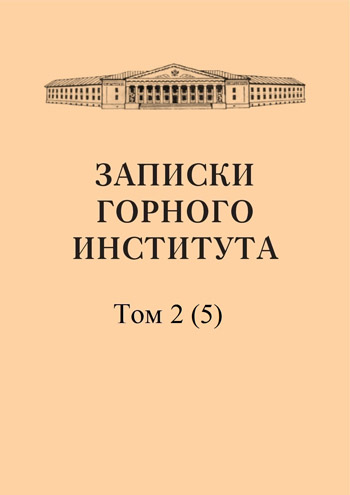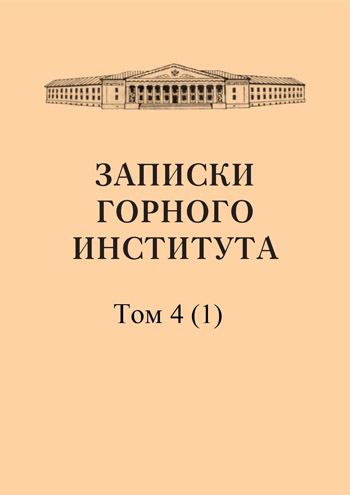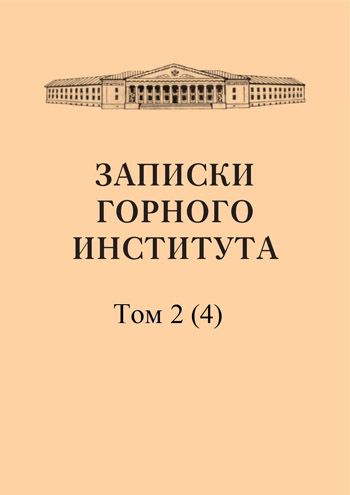-
Date submitted1909-11-20
-
Date accepted1910-01-04
-
Date published1910-05-01
Determination of mesh densities of crystalline faces without constructions
- Authors:
- V. I. Sokollov
- D. N. Artem'ev
In his article “Image of the structure of a crystal with vectorial circles” Prof. E.S. Fedorov outlines a graphical method for finding the densities of meshes of crystal faces (more precisely: the squares of the densities of the corresponding meshes). Anyone who has dealt with determining the densities of meshes of faces using this method knows that in this case one should make some constructions, not particularly complex, but nevertheless quite time-consuming.This article aims to show how the task can be simplified by reducing drawing work to a minimum.
-
Date submitted1909-11-13
-
Date accepted1910-01-25
-
Date published1910-05-01
Additional notes on the article by Sokolov and Artem'ev on determining mesh density
- Authors:
- E. S. Fedorov
The usefulness of compiling such detailed tables becomes clear, which, of course, will be compiled when it is necessary to make more accurate calculations of the densities of face networks or edge densities. In all cases in general, except for triclinic crystals, such calculations will be distinguished by significant simplicity, or more precisely, not at all will be needed when the tables are compiled. Accuracy can also be enhanced when using the graphical method, if we take as a basis for calculations not gnomostereographic (or gramstereographic), but gnomonic (or linear) projections.
-
Date submitted1909-11-03
-
Date accepted1910-01-23
-
Date published1910-05-01
Study of crystals of two double salts of molybdic acid
- Authors:
- M. K. Eliashevich
Double salts of molybdic acid, cobalt-potassium and cobalt-ammonium, were obtained by Professor Kurnakov and transferred to the Mineralogical Institute for crystallographic research. The research results and optical properties of the crystals are described in this article.
-
Date submitted1909-11-07
-
Date accepted1910-01-09
-
Date published1910-05-01
Crystallization of cobalti-nitro-aquo-dimethylglucimine
- Authors:
- D. N. Artem'ev
- V. M. Lomberg
Cobalt-nitro-aquo-dimethylglucimine was first obtained by L.A. Chugaev, who transferred it to the Mineralogical Institute (Mining Institute) for crystallographic research. For the research results and crystal measurement tables, see the article.
-
Date submitted1909-11-26
-
Date accepted1910-01-05
-
Date published1910-05-01
Automatic brake incline (Brembergbrake)
- Authors:
- A. Radkevich
When hauling coal along a brake incline with an endless chain or rope, it is sometimes necessary to use such an organization in which the number of trolleys located on the incline constantly changes. This happens, for example, when supplying coal from different horizons. Under the influence of a changing load on the rope from a different number of trolleys attached to it, their speed of movement would have to change. To prevent this, various devices are installed at the end pulley, which regulate the speed. So, for example, a brake of any system is installed, and the speed is regulated by the person in charge. These brakes did not live up to the expectations placed on them. The path was constantly clogged, resistance increased, and the incline with such a device refused to act. I propose to use an automatic the brake incline, which I invented in these cases, as it does not have the disadvantage indicated above. Speed adjustment is achieved automatically under the influence of increasing load on the rope. Its main qualities are the simplicity of the device, low cost, and durability.
-
Date submitted1909-11-16
-
Date accepted1910-01-26
-
Date published1910-05-01
Preliminary experiments to determine the expansion coefficients of crystals using the method of E. S. Fedorov
- Authors:
- S. O. Maizel
The objective of the work is to determine the thermal expansion coefficients of crystals using the method proposed by prof. E. S. Fedorov. The principle of the method is as follows: a plate is cut out of the crystal along the required plane and on one side of it, in one way or another, a diffraction grating is applied, the lines of which are perpendicular to the direction in which it is desirable to determine the expansion coefficient. If a beam of monochromatic light is passed through such a grating normal to the surface, then a series of deflected rays will be obtained, the angles of which with the normal obey the following law (see article).
-
Date submitted1909-11-04
-
Date accepted1910-01-25
-
Date published1910-05-01
Crystallography for forty years
- Authors:
- E. S. Fedorov
Realizing the state of crystallography which I found 40 years ago, and comparing it with the present, I find that its transformation during this period is almost deeper than any other science. The closeness of crystallography and chemistry seems natural: both belong to sciences of an intermediate nature between exact sciences, the study of which is entirely reduced to the application of mathematical methods, and descriptive sciences, where the mathematical method is not applied at all. If we compare the role of mathematics in chemistry and crystallography 40 years ago and now, we will of course see that the latter has undergone a much greater transformation.
-
Date submitted1909-11-02
-
Date accepted1910-01-16
-
Date published1910-05-01
Cognate geometric systems
- Authors:
- E. S. Fedorov
When dualism was recognized in the New Geometry, only two geometric systems were assumed: a system of points and a correlative system of planes. This note aims to show the special significance of such a particular case, which is expressed by the following theorem, if we call two such correlative systems, in which the spheroprims of one are correlative to the spheroprims of the other, cognate systems. All constructions, and therefore theorems, of one related system are transferred to another. In addition, I mean to show that it is possible to establish such systems that for each of its linear seconds it is possible to reproduce a related system of points on the plane.
-
Date submitted1909-11-27
-
Date accepted1910-01-05
-
Date published1910-05-01
Colloidal ice
- Authors:
- P. P. von-Weymarn
I tried to implement the conditions of dispersoid condensation to obtain colloidal ice; my efforts were successfull. See the note: 1. Solid suspension solutions of ice. 2. Liquid suspension solutions of ice. The example given in the message of obtaining ice in a colloidal state can most clearly confirm my position on the generality of the colloidal state (1906) and my opinion that this state is the result of the corresponding directions of the condensation process.
-
Date submitted1909-11-07
-
Date accepted1910-01-06
-
Date published1910-05-01
On the phenomena observed when liquid air is mixed with water
- Authors:
- P. P. von-Weymarn
I now repeated the experiments described in my message “Colloidal Ice” again, now with liquid air, highly enriched with oxygen (boiling point about -185°) and with the same success. See the note: 1. About the solidification of water when mixed with liquid air. 2. On the production of dispersed systems such as: Ice - liquid air.
-
Date submitted1909-11-15
-
Date accepted1910-01-16
-
Date published1910-05-01
Interesting examples of complex disperse systems
- Authors:
- P. P. von-Weymarn
As I have previously proven, when mixing sufficiently concentrated reacting solutions, any body that is slightly soluble in the selected dispersion medium is obtained in the form of a coarse jelly. The general situation is as follows: by changing the rate of condensation of molecules W, any body, regardless of its chemical and physical properties (such as chemical composition, solubility, etc.) can be obtained in crystals of any degree of dispersion, both very large and negligible.
-
Date submitted1909-11-22
-
Date accepted1910-01-02
-
Date published1910-05-01
Sodium chlorate jelly
- Authors:
- P. P. von-Weymarn
In my previous works, I gave a formula for obtaining sodium chlorate in a colloidal state. At room temperature, as is known, one cannot expect the formation of any significant quantities of esters, so the mechanism of the above reaction is very simple. In view of the decrease in the solubility of NaCl with decreasing temperature, it is very useful, especially for obtaining stable NaCl salts, to carry out reactions at low temperatures (see message).
-
Date submitted1909-11-05
-
Date accepted1910-01-20
-
Date published1910-05-01
Elastic rubber-like sulfur
- Authors:
- P. P. von-Weymarn
When a thin stream of molten sulfur superheated above 400° is poured into liquid air, sulfur is obtained in the form of very thin threads, 0.5-1 mm in diameter. The threads taken out of liquid air are at first quite hard and brittle, but then, as soon as the temperature rises somewhat, they acquire extraordinary elasticity, similar to the elasticity of rubber. The easier it is to obtain a body in a gelatinous or glassy form, the more capable it is of giving various modifications. Sulfur is the most typical example of such bodies.
-
Date submitted1909-11-18
-
Date accepted1910-01-03
-
Date published1910-05-01
Similarities and differences between gaseous, dissolved, and colloidal states
- Authors:
- P. P. von-Weymarn
The author describes in detail the gaseous and dissolved states; the osmotic pressure of colloidal solutions, as well as the differences between suspensoid (colloidal) and suspended (true) solutions. Highly dispersed colloidal solutions have quite measurable osmotic pressure, and this pressure cannot be less than gas pressure under the same conditions.
-
Date submitted1909-11-13
-
Date accepted1910-01-17
-
Date published1910-05-01
Crystals of one organic compound of cobalt
- Authors:
- D. N. Artem'ev
Cobalt-diamine-dimethylglucimine chloride was obtained by L.A. Chugaev and presented by him to the Mineralogical Institute for crystallographic research (see article). Goniometric measurements (on a university, goniometer by E. S. Fedorov) and optical observations in polarized light revealed that the crystals belonged to the tetragonal system, the class of which could not be determined.
-
Date submitted1909-11-11
-
Date accepted1910-01-12
-
Date published1910-05-01
Calculation of spherical coordinates of faces after displacement
- Authors:
- D. N. Artem'ev
Especially for triclinic crystals, when finding the faces of the vertical belt from tables of mesh densities, it is necessary to make a displacement of the defining faces, and such a displacement should be made with greater accuracy, compared with that which we can achieve graphically. In this case, it will be necessary to calculate the spherical coordinate ρ, which defines the faces after the disp;acement. Solving the question of such a calculation does not present any difficulty, and is already partly contained in one of the formulas given in the article by Sokolov and myself “Determination of the densities of networks of crystalline faces without the help of constructions".
-
Date submitted1909-11-16
-
Date accepted1910-01-12
-
Date published1910-05-01
About original figures on cleavage planes in hambergite
- Authors:
- V. I. Sokolov
A sample of the rare mineral Hambergite from a new deposit on the island of Madagaskar was sent to the Museum of the Mining Institute from the Bohm Mineralogical Office in Vienna. The article presents research data on a rare mineral and a description of the original figures on some fusion fragments.
-
Date submitted1909-11-17
-
Date accepted1910-01-22
-
Date published1910-05-01
Several formulas related to the zonal calculation system
- Authors:
- E. S. Fedorov
In the article “Extreme simplification of zonal calculations and crystallographic calculations in general,” I noted the extreme simplicity that calculations of spherical bipolar coordinates obtain if we take Miller’s formula as a basis. Now I will supplement the formulas derived then with those that relate to the calculation of the cotangents of the angles formed with any initial face of the belt (see note). We can conclude that the system of zonal calculations with bipolar coordinates, in its special simplicity, is applicable without the use of a sequential, recursive course of calculation, and directly to faces with arbitrary complex indices.
-
Date submitted1909-11-06
-
Date accepted1910-01-13
-
Date published1910-05-01
Considerations about the laws of twins
- Authors:
- E. S. Fedorov
Here I mean only what is meant by the word “twins”, and not those natural accretions that are caused by mechanical shifts - a case already discussed in my previous works. It seems to me that the experiments of the correct growth of dissimilar crystals on each other and the conclusions drawn from them by F. Barker completely establish the physical reason for the formation of twins. The most general conclusion from the principle is that the possibility of twinning growth along any plane of the complex, no matter how complex the symbol may be its expression, for cases of twinning faces with a complex symbol, is used in nature in exceptional circumstances.
-
Date submitted1909-11-09
-
Date accepted1910-01-29
-
Date published1910-05-01
Approximated division of the circumference of a circle into equal parts by rays from the center
- Authors:
- E. S. Fedorov
Vl. Meyer addressed me with a letter, in which he reported on a graphical method of dividing a circle into equal parts using a simple technique (see article). Of course, theoretically this is not correct; it is impossible even to generally establish the perspective of points on a circle and on any straight line otherwise than by taking the center of the perspective rays on the circle itself. Mr. Meyer's method has no theoretical basis and can only be approximate in relation to the semicircle. This method can really be used at least in construction work, for example, when placing pillars and columns around the circumference of a circle.
-
Date submitted1909-11-28
-
Date accepted1910-01-16
-
Date published1910-05-01
Double character conversion expression
- Authors:
- E. S. Fedorov
When solving problems about the correct installation of crystals (as a basis for crystal chemical analysis), one constantly has to resort to symbol transformation, while verification of this solution is associated with the second and further transformations. There is a problem of expressing the final symbols in the original ones. Instead of the well-known conversion formula, in practice we use an abbreviated expression in the form of a determinant (see article).
-
Date submitted1909-11-21
-
Date accepted1910-01-24
-
Date published1910-05-01
A simple general method for obtaining any body in the state of solid colloidal solutions of any degree of dispersion, starting from molecular
- Authors:
- P. P. von-Weymarn
- I. V. Kagan
Our experiments with alcohol solutions of Na Br, KC1 and NaCl gave exactly the same results as for sulfur and phosphorus. To avoid the absorption of water by alcohol, experiments must be carried out in these cases in hermetically sealed test tubes, inside of which, above the surface of the alcohol, hangs a cup (of a special device) with phosphorus anhydride. Such a device is essential, because the solubility of the mentioned salts increases (for S and P, on the contrary, it decreases) from the absorption of water by alcohol, and the increase in solubility during the experiment greatly affects the course of condensation and dispersion processes when heating solid suspension solutions.


